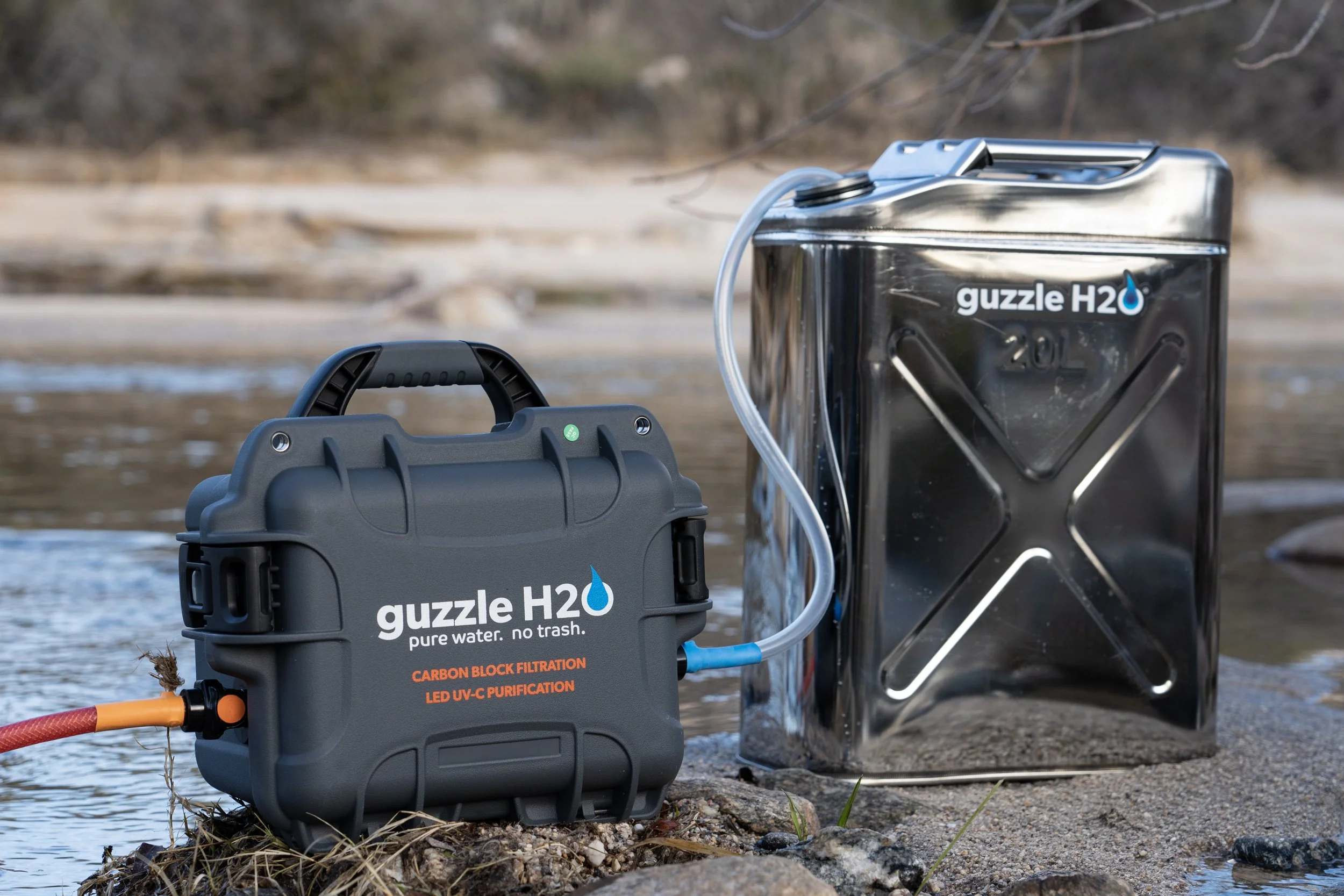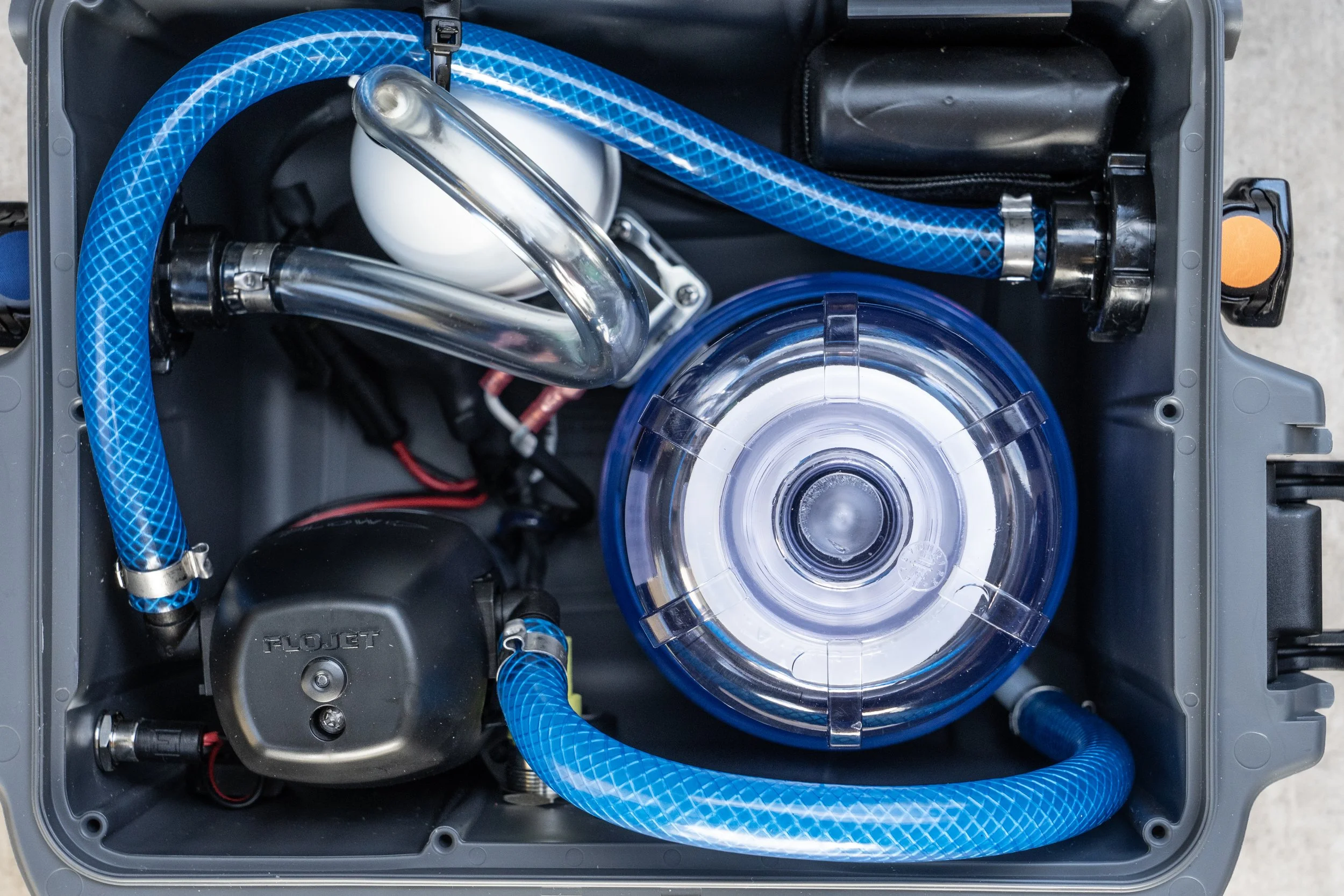The Guzzle H2O Stream: One purifier to rule them all?
All-in-one, fast purification. (The nifty stainless-steel jerry can is optional.)
Like it or not, the days are long gone when we could go a-wandering, knapsack on our back, and dip our Sierra Club cup into any lake or stream we came to. (And to be frank, the Sierra Club cup was a really lousy design anyway.)
Depending on which studies and statistics you believe, anywhere from 60 to 80 percent of the surface water—lakes and streams—in the U.S. is significantly contaminated with something not good for you, from E. coli to mercury. There are probably a few creeks at 12,000-feet-plus in the Rockies that are still as pure as God intended them, but everywhere else you’d be wise to ensure the water you use from natural sources has been purified, or at least filtered.
What’s the difference? In general, a filter is designed to remove such waterborne pathogens as protozoa (e.g., Giardia and Cryptosporidium) and bacteria (e.g., Salmonella and E. coli). A purifier will kill these organisms as well as viruses. Until recently, consumer-grade water filters could not block the passage of viruses, which average just .02 microns in diameter compared to the relatively huge size of bacteria (.2 to 1 micron) and protozoa (2 to 50 microns). The historically accepted methods for killing viruses included exposure to UV light, treatment with iodine, and boiling. Today several companies produce filters capable of blocking viruses, so the distinction has become somewhat blurred.
Do you need a purifier? At this time, for travel in North America, probably not, as viral contamination of surface water is relatively rare here (potential exceptions include, for example, lakeshores with heavy human activity). However, if your plans include exploration of developing-world countries, it’s definitely worth considering, as viral pathogens such as hepatitis A and E, norovirus, adenovirus, and enteroviruses, among others, might be present. And, after all, there’s no such thing as water that’s too pure.
There are dozens of filters on the market—including those capable of blocking viruses—suitable for backpackers and canoeists, who might need no more than a gallon or two per day. The MSR Guardian Purifier (the pump version) is one such. For overland travelers who have bulk water tanks in their vehicles, and who use that water for washing dishes and perhaps showering, and who thus might go through three, four, or more gallons per day per person, the work and time involved in hand-pumping a liter or two per minute would get old really fast.
One leisurely but effective solution is MSR’s Guardian Gravity purifier, which comprises a gravity-fed filter capable of eliminating viruses (NSF P248 standard), fed by a 10-liter hanging bag. The system produces only about a half-liter per minute (and it must be cleared of silt and debris in advance), but if you’re in camp for a few hours you can easily produce 20 or 30 liters of pure water. Of course you need to set a timer or keep an eye on the unit to know when to refill, and topping it up more frequently helps push water through the filter (slightly) more quickly. But otherwise it’s completely passive.
Want something faster than that? I’ve recently been using what might be the best high-output water-purification system I’ve ever tried.
The Stream from Guzzle H20 (Okay, I would have picked a different company name) comprises, in a compact Pelican-like case about ten by twelve by eight inches, a primary, easily replaced .5-micron carbon-block filter, a 12V pump powered by an LiFePO4 battery, and a transparent capsule incorporating an LED UV-C light source. The carbon-block filter removes chlorine taste and odor, and reduces or eliminates NSF 41 contaminants, VOCs (volatile organic compounds) lead, and mercury. The UV-C light inactivates protozoa, bacteria, and viruses with 99.99-percent efficiency, according to third-party testing. And the Stream produces an astounding .75 gallons per minute in pumping mode, or 1.1 gpm with a pressurized source such as a municipal tap. The LiFePO4 power source will process 32 gallons on a single charge in pumping mode.
What this means is that the Stream could completely refill our Land Cruiser Troop Carrier’s 29-gallon tankage (24-gallon chassis tank plus jerry can) with purified water on a single charge and in about 38 minutes—significantly less if sourced from a municipal tap. No other system I know of comes close.
Using the Stream couldn’t be simpler. The inlet hose plugs into a quick disconnect fitting on one side of the case; the outlet hose into a similar fitting on the other side. The inlet is color-coded red (in fact the entire hose is red); the outlet blue to avoid confusion. Stick the 1-micron pre-filter of the inlet hose into the source, hold the outlet hose over your container, and hit the switch. You’ll be surprised at the rate of flow—the thing fills a standard water glass in a few seconds.
I opted for the “Overland bundle,” which includes an extra carbon-block filter and a 30-foot outlet hose, so you don’t have to park right next to a source if you have built-in tanks in your vehicle. I also got the significantly larger “Guide” prefilter to clear up the murkiest swamp water.
With this setup I would have felt completely comfortable exploiting natural or municipal water sources anywhere I have traveled on any continent. I was impressed with the thought behind the system, the quality of the components and assembly, and the speed—and taste—of the output.
As you might imagine, the Stream is a significant investment. The standard model is $1,195; the Overland bundle is $1,288, and the Guide prefilter is $65. However, given that safe drinking water is arguably the number one concern on any trip, you might consider it a bargain. I do.





